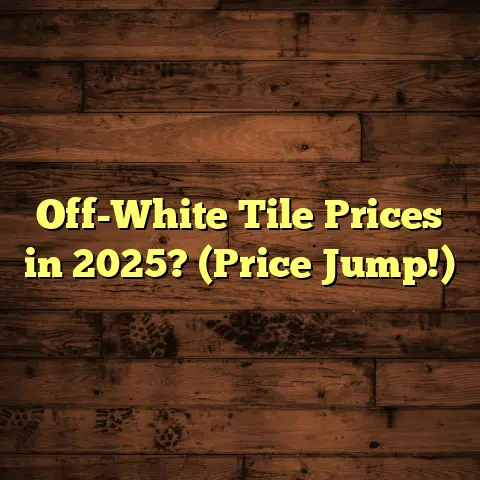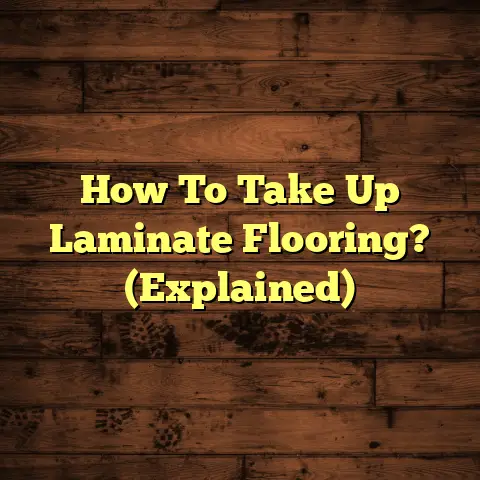Bleach On Hardwood Floors? (5 Min. Damage Check!)
I’ve seen it all when it comes to hardwood floors, and trust me, I understand the desire to keep them looking pristine.
A well-maintained home is more than just a place to live; it’s an investment, a sanctuary, and a reflection of you.
And let’s be honest, those gorgeous hardwood floors are a HUGE part of that aesthetic appeal.
Think about it: families with kids, pet owners dealing with muddy paws, active individuals tracking in who-knows-what.
Life happens, right?
Spills, stains, and the constant need for cleaning are just part of the package.
But here’s the thing: maintaining those beautiful hardwood floors can feel like a constant battle,
especially when you’re bombarded with all sorts of cleaning products promising miraculous results.
And that’s where things can get tricky.
One product, in particular, tends to raise a lot of eyebrows (and cause a lot of headaches): bleach.
“Can I use it? Should I use it? What happens if I do?”
These are the questions I hear all the time.
So, let’s dive right in.
This article is all about exploring the potential disaster (or non-disaster!) of using bleach on your hardwood floors.
I’m going to give you the lowdown on what bleach actually does to wood, and most importantly,
I’ll walk you through a super quick, 5-minute damage check you can do yourself right now.
Ready? Let’s get started!
Understanding Bleach
First things first: what is bleach, anyway?
In simple terms, bleach is a chemical solution widely used as a disinfectant and cleaning agent.
You’ll find it in countless household products, from laundry detergents to bathroom cleaners.
The active ingredient in most household bleach is sodium hypochlorite (NaClO).
This chemical compound is a powerful oxidizing agent, meaning it readily donates oxygen atoms to other substances.
Think of it like this: bleach is like a tiny, aggressive Pac-Man, gobbling up stains and germs by disrupting their chemical structure.
Now, why would anyone even think about using bleach on hardwood floors?
Well, I’ve heard all sorts of reasons over the years.
Some homeowners believe it’s the ultimate stain remover, capable of tackling even the most stubborn marks.
Others think it’s the best way to disinfect floors, especially if they have pets or young children.
And let’s be real, the promise of a sparkling clean, germ-free floor is pretty tempting, right?
However, here’s where the misconceptions come in: bleach isn’t a magic bullet, especially for hardwood.
Its strong oxidizing properties, while effective for disinfecting, can be incredibly harsh on wood and its finish.
I’ve seen firsthand the damage it can cause, and it’s not pretty.
The Impact of Bleach
on Hardwood Floors
Okay, so now we know what bleach is. Let’s talk about what it does to your precious hardwood floors.
The impact of bleach really depends on a few factors, including the type of finish on your floor
(water-based or oil-based), the concentration of the bleach, and how long it’s left on the surface.
But here’s the general rule of thumb: bleach is NOT your friend when it comes to hardwood.
Finish Damage:
First, let’s talk about the finish.
Hardwood floors are typically coated with a protective layer, whether it’s a polyurethane, varnish, or wax.
This finish is what gives your floors their shine and protects the wood from moisture, scratches, and everyday wear and tear.
Bleach, being a strong oxidizing agent, can wreak havoc on this finish.
It can strip away the protective layers, leading to dullness, discoloration, and even complete removal of the finish.
Water-based Finishes:
Water-based finishes are generally more susceptible to damage from bleach.
The chemicals in bleach can break down the polymers in the finish, causing it to become cloudy or even peel.
Oil-based Finishes:
Oil-based finishes are slightly more resistant, but they’re still not immune.
Bleach can still penetrate the finish, causing discoloration and potentially weakening the bond between the finish and the wood.
Wood Damage:
But the damage doesn’t stop at the finish.
If bleach penetrates the finish (and it often does), it can directly affect the wood itself.
Bleach can lighten or discolor the wood, creating uneven patches or streaks.
In some cases, it can even weaken the wood fibers, making them more prone to cracking or splintering.
The Science Behind the Damage:
Here’s a little bit of science to explain what’s happening:
Bleach’s oxidizing properties break down the lignin in the wood.
Lignin is a complex polymer that gives wood its rigidity and color.
When bleach attacks the lignin, it disrupts the wood’s natural structure, leading to discoloration and weakening.
Real-Life Horror Stories:
I’ve seen countless cases where homeowners have regretted using bleach on their hardwood floors.
I remember one client who tried to remove a pet stain with bleach, only to end up with a large, bleached-out spot
that required a complete refinishing of the entire floor.
Another client used bleach to try to disinfect their floors after a water leak, resulting in widespread discoloration
and a costly restoration project.
These stories aren’t just anecdotes; they’re a testament to the potential damage bleach can inflict.
Quick Damage Check
Alright, so you’ve used bleach on your hardwood floors. Don’t panic!
The first thing to do is assess the damage.
Here’s a quick, 5-minute damage check you can do right now:
Step 1: Visual Inspection:
Take a good, hard look at the affected area.
What do you see?
- Discoloration: Is the area lighter or darker than the surrounding wood?
- Dullness: Does the finish look cloudy or less shiny than the rest of the floor?
- Changes in Sheen: Is the sheen uneven or inconsistent?
Step 2: Texture Test:
Run your hand over the affected area.
How does it feel?
- Rough Texture: Does the surface feel rough or uneven?
- Sticky Residue: Is there any sticky residue on the surface?
Step 3: Water Test:
This test helps you assess whether the finish has been compromised.
- Place a few drops of water on the affected area and observe what happens.
- If the water beads up, the finish is likely still intact.
- If the water soaks in quickly, the finish has been damaged, and the wood is exposed.
Step 4: The “Smell” Test:
This might sound weird, but give the area a sniff.
- Do you smell a strong chemical odor, even after cleaning?
- This could indicate that the bleach has penetrated the wood.
Document Your Findings:
Take photos of the affected area from different angles and in good lighting.
Write down everything you observe, including the size of the affected area, the color changes, and any texture changes.
This documentation will be invaluable if you need to consult with a professional later on.
What Your Findings Mean:
- Minimal Damage: If you only see slight discoloration and the water test shows that the finish is still intact, you might be able to address the issue with some gentle cleaning and polishing.
- Moderate Damage: If you see noticeable discoloration, rough texture, or the water test shows that the finish is compromised, you’ll likely need to consult with a professional.
- Severe Damage: If you see significant discoloration, cracking, or splintering, the damage is likely extensive, and you may need to consider refinishing or replacing the affected boards.
Alternative Cleaning Solutions
for Hardwood Floors
Okay, so bleach is a no-go.
What can you use to keep your hardwood floors clean and sparkling without causing damage?
Thankfully, there are plenty of safe and effective alternatives.
Natural Cleaning Solutions:
- Vinegar Solution: A diluted vinegar solution (1/2 cup of white vinegar per gallon of water) is a great all-purpose cleaner for hardwood floors. The acidity of the vinegar helps to cut through grime and remove stains, while the water dilutes it enough to prevent damage to the finish.
- Soap-Based Cleaners: Look for pH-neutral soap-based cleaners specifically designed for hardwood floors. These cleaners are gentle enough to remove dirt and grime without stripping the finish.
- Baking Soda Paste: For stubborn stains, try making a paste of baking soda and water. Apply the paste to the stain, let it sit for a few minutes, and then gently scrub with a soft cloth. Be sure to rinse thoroughly with clean water.
Commercial Hardwood Floor Cleaners:
There are tons of commercially available hardwood floor cleaners on the market, but it’s important to choose wisely.
- Read the Labels: Look for cleaners that are specifically labeled as “pH-neutral” and “safe for hardwood floors.”
- Avoid Harsh Chemicals: Steer clear of cleaners that contain ammonia, bleach, or other harsh chemicals.
- Consider the Finish: Some cleaners are designed for specific types of finishes (e.g., water-based or oil-based). Make sure you choose a cleaner that’s compatible with your floor’s finish.
The Importance of pH Balance:
pH balance is crucial when it comes to cleaning hardwood floors.
- Neutral pH: A pH of 7 is considered neutral. Cleaners with a neutral pH are gentle and won’t damage the finish on your floors.
- Acidic Cleaners: Cleaners with a pH below 7 are acidic. While acidic cleaners can be effective for removing certain types of stains, they can also be harsh on hardwood finishes.
- Alkaline Cleaners: Cleaners with a pH above 7 are alkaline. Alkaline cleaners can also be harsh on hardwood finishes, potentially causing discoloration or dullness.
Tips for Maintaining Hardwood Floors:
- Regular Cleaning: Sweep or vacuum your hardwood floors regularly to remove dirt and debris.
- Damp Mopping: Mop your floors with a damp (not wet!) mop and a pH-neutral cleaner.
- Protective Measures: Use rugs and mats in high-traffic areas to protect your floors from wear and tear.
- Avoid Standing Water: Clean up spills immediately to prevent water damage.
- Use Furniture Pads: Place felt pads under furniture legs to prevent scratches.
Professional Help
and Restoration Options
Sometimes, despite our best efforts, the damage is done.
If you’ve used bleach on your hardwood floors and the damage is significant, it’s time to call in the pros.
When to Seek Professional Help:
- Extensive Discoloration: If you have large areas of discoloration that you can’t remove with gentle cleaning.
- Finish Damage: If the finish on your floors is peeling, cracking, or completely worn away.
- Wood Damage: If the wood itself is cracked, splintered, or warped.
Professional Services Available:
- Refinishing: Refinishing involves sanding down the existing finish and applying a new coat of finish. This can restore the original beauty of your floors and repair minor damage.
- Repairing: If only a few boards are damaged, a professional can replace them with new boards that match the existing flooring.
- Replacing: If the damage is too extensive to repair, you may need to replace the entire floor.
What to Expect During the Assessment and Restoration Process:
- Assessment: A professional flooring contractor will assess the damage and provide you with a detailed estimate.
- Timeline: The timeline for restoration will depend on the extent of the damage and the services required. Refinishing typically takes a few days, while replacing an entire floor can take a week or more.
- Costs: The cost of restoration will vary depending on the services required and the size of the affected area. Refinishing typically costs between \$3 and \$8 per square foot, while replacing a floor can cost between \$5 and \$15 per square foot.
Conclusion
So, there you have it.
Bleach and hardwood floors are a recipe for disaster.
While maintaining a clean home is essential, it’s equally important to protect your investment in hardwood flooring.
Choose your cleaning products wisely, prioritize the longevity of your floors over immediate cleaning results,
and when in doubt, consult with a professional.
By being informed and proactive, you can keep your hardwood floors looking beautiful for years to come.
Thanks for reading, and happy cleaning!





